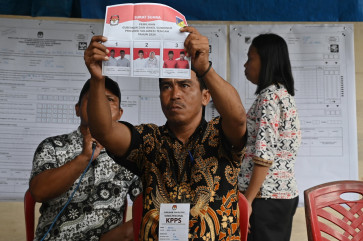Popular Reads
Top Results
Can't find what you're looking for?
View all search resultsPopular Reads
Top Results
Can't find what you're looking for?
View all search resultsBank Indonesia's agenda to boost lending growth in 2024
BI, as the monetary authority, will again inject liquidity into the banking industry next year by increasing macroprudential liquidity policy incentives and loosening the macroprudential liquidity buffer ratio.
Change text size
Gift Premium Articles
to Anyone
T
he agenda to spur bank lending will continue next year. Bank Indonesia (BI) Governor Perry Warjiyo affirmed this message in his speech when delivering his report to President Joko “Jokowi” Widodo at the central bank’s annual meeting on Nov. 29. At that event, the President called on banks not to be too careful in disbursing credit to businesses so that the real sector engine can roar again. That way, Indonesia's economic growth will soar.
The President's criticism is reasonable. Banking data show that credit growth has not been able to pass 15 percent for almost a decade. Previously, Indonesian banks had recorded high credit growth of over 26 percent in 2012-2013. The lack of optimal credit disbursement has caused annual economic growth to remain stagnant in the range of 5 percent.
Initially, during the COVID-19 pandemic in 2021, credit distribution was promising, it was starting to grow positively in the second half of the year during the peak of the pandemic but since April 2023 it has slowed down back to below 10 percent. The lending capacity actually could allow for higher credit growth, as indicated by the loan-to-deposit ratio (LDR) of 83 percent. If we expand the scope of funding sources with securities issued, borrowing received and rights issues, the ratio will become lower.
Undisbursed funds are placed by banks in liquid and safe instruments, mostly in government securities (SBN). Not surprisingly, the liquid assets to third-party funds ratio (AL/DPK) is quite high, reaching 26.36 percent in October 2023.
The President also criticized the banks’ large holdings in SBN, instead of disbursement of loans to industry and micro, small, and medium enterprises (MSMEs).
In response to such conditions, BI, as the monetary authority, will again inject liquidity into the banking industry next year by increasing macroprudential liquidity policy incentives and loosening the macroprudential liquidity buffer ratio. From these two policies, it is hoped that bank liquidity will increase by at least Rp 159 trillion (US$101.7 billion) and Rp 81 trillion, respectively. This additional liquidity will add ammunition for banks to boost lending.
The policy to keep flooding liquidity into banks to encourage lending is well-founded. Liquidity is a source of funds for lending. Abundant liquidity will not encourage banks to seek public funds. As a result, deposit interest rates are relatively stable, so lending rates will not increase greatly.



















